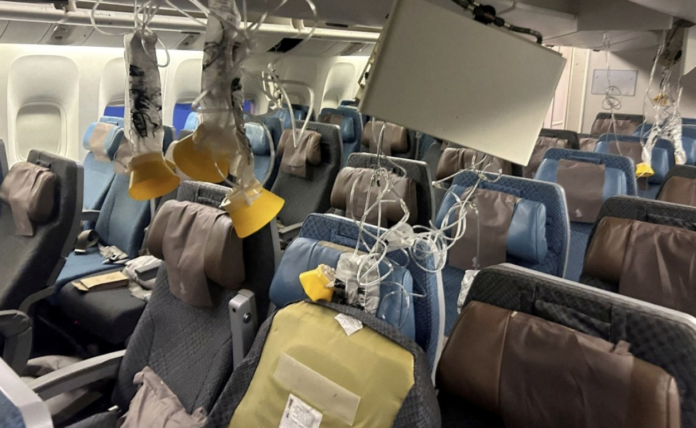KUALA LUMPUR, May 24 – Kudos to the heroic pilots of Singapore Airlines flight SQ321 whose swift action saved 228 people on board when a severe turbulence hit the flight, but the horrific incident has renewed the focus on safety and serves as a chilling reminder for passengers to keep their seatbelts on.
And according to a study for aircraft, the skies are up to 55 per cent far bumpier today than four decades ago.
Malaysian student Dzafran Azmir, 29, and a passenger on SQ321, recounted how those not wearing seatbelts were launched into the air, hitting the ceiling.
Some 30 passengers were injured on the flight heading to Singapore from London. Unfortunately a 75-year old Briton died of a heart attack.
Quick action by the pilots enabled the plane to make a successful emergency landing at Suvarnabhumi International Airport in Bangkok.
It was 90 minutes short of its destination and over the Irrawaddy Basin at an altitude of 37,000 feet, about 10 hours after departure. There is no doubt that a majority of passengers unfasten their seatbelts when planes reach a cruising altitude and the seatbelt sign is switched off.
This is despite public service announcements by all pilots in all flights for air travellers to keep their seatbelts buckled at all times when seated. It has become a usual practice to unfasten seatbelts until the planes is about to land or when a turbulence is detected.
However, in SQ321’s case, there was no warning of any turbulence, and it rocked the Boeing 777-300ER plane that had 18 crew members, including the pilots and 211 passengers.
While turbulence in the form of extreme weather condition is common, the pilot’s swift action and decision making is equally critical in saving the plane, navigating the unstable aircraft and ensuring a safe landing.
Probes on aircraft incidents such as the one which hit the plane may take months, but one thing that could be gauged from what passengers recounted is the importance of adhering to safety procedures at all times.
We are all guilty of gazing out the window, flipping through a magazine or completely dozing off while flight attendants go through their safety demonstration before takeoff.
Yet, those few minutes could make such a big difference in emergency circumstances and not to mention the announcement by the pilot to keep seatbelts on.
Though turbulence-related fatalities are quite rare and hitting bumpy air is a minor incident, unstable air that moves in a non-predictable way poses a threat to lives.
One such occurrence is the Clear Air Turbulence (CAT) that manifests in cloud-free air without any visual indicators such as clouds and no visible warning ahead.
It catches everybody off-guard and possibly not enough time for pilots to react decisively.
FlightRadar24 showed that SQ321 was cruising at an altitude of 37,000 feet over the Andaman Sea off the coast of Myanmar shortly after 9 am British Summer Time (BST) when it sharply dropped by 6,000 feet, which according to experts could have been the pilot’s reaction to the situation.
Thai Pilots Association president Captain Teerawat Angkasakulkiat reportedly said one situation that is impossible to prepare for is when the skies are clear, and the plane’s radar does not detect anything amiss.
Similarly, Universiti Kuala Lumpur Malaysian Institute of Aviation Technology economist (aviation and aerospace) Associate Prof Mohd Harridon Mohamed Suffian acknowledges that certain CAT situations are difficult to detect like in the case of SQ321, which is why the pilots’ swift action is commendable.
“Nevertheless, it’s beneficial for airlines to be proactive and apply the Mathematical Model of Probabilistic Approach to calculate the probability that turbulence would occur in particular areas that are prone to turbulence,” he told Bernama.
Mohd Harridon pointed out that climate change also contributes to such incidents.
“Climate change contributes to such events as it asserts randomness upon the differential pressure of certain regions and this makes the wind magnitude and direction erratic in nature and subsequently it’s difficult to predict the weather pattern,” he said.
Captain Dave Wallsworth, an experienced pilot, through his X handle @DaveWallsworth said the type of events which the SIA flight went through are extremely rare considering the number of flights worldwide everyday.
However, this is also a reminder that flying is a dynamic situation and pilots deal with nature and weather conditions in a constantly changing environment, he said.
Hence, it is important to keep the seatbelt fastened even when the sign is off, he wrote.
“It isn’t uncomfortable and could prevent serious injury if we are unfortunate enough to encounter turbulence. But please remember, flying is still the safest way to travel and we, as your crew, will always do our very best to keep you (and us) as safe as we possibly can,” he said.
















